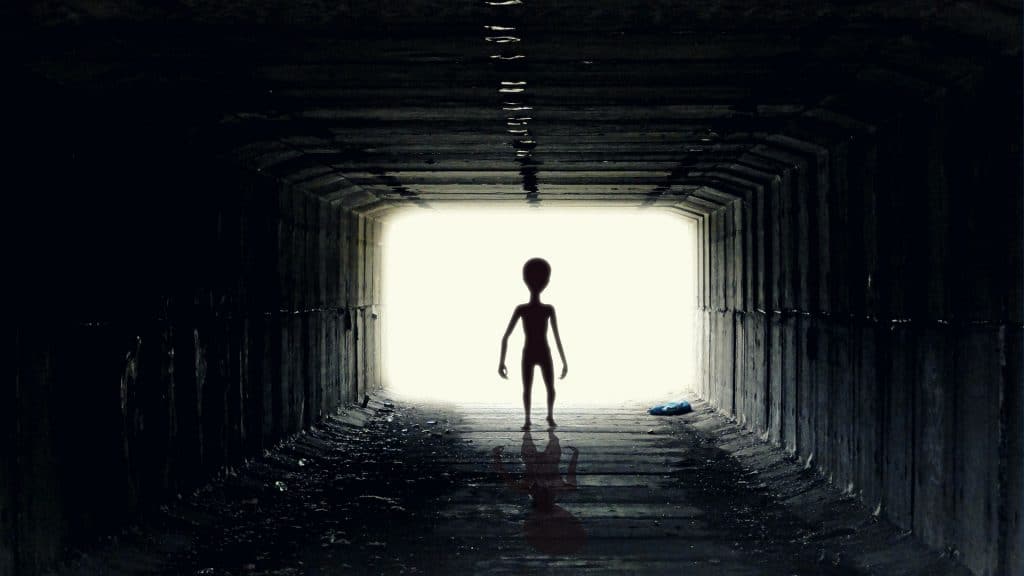This article originally appeared in The Skeptic, Volume 4, Issue 6, from 1990.
There seems little doubt that the late Ray Palmer was, if not the ‘father of flying saucers’, then at least the midwife who assisted at the birth of the most intransigent mystery of this, or any other century. The parameters he ably established when he first espoused the ufological cause by publishing I Did See The Flying Discs by Kenneth Arnold in the pages of the first issue of his brand new magazine Fate in 1948, still have considerable influence today – especially in America where the ‘Aliens from Space Syndrome’ has gained a new lease of life by the implementation of the Freedom of Information Act.
Throughout his life Palmer publicised the ufological cause, first in the pages of Fate, subsequently in another magazine he later founded – Flying Saucer. From the material he published, readers could be forgiven for thinking that Palmer thought the term flying saucer a euphemism for spaceship. In fact, so apparently uncompromising was he in his approach to the subject, it is said that he finally provoked an exasperated American establishment into openly accusing him of ‘inventing flying saucers to further sales of his magazines’. ‘What a load of Bolides!’ – you might say. But be careful you don’t speak too soon.
Although, with the advent of Kenneth Amold, and after his involvement with The Maury Island Hoax, Palmer took up the literary gauntlet on behalf of ET, it is noticeable in his later years that he returned to a theme, older and more occult, which had apparently lost him his job during his editorial youth. According to what he wrote in his article ‘Saucers from Earth?’ which appeared in this country in a Tandem Special, The Allende Letters, published in 1968, he was again speculating that the UFOs originated on Earth. He wrote: ‘While it is true that there are many interplanetary mysteries, linking them with UFOs demands a stretching of the evidence, and a great deal of extrapolation.’
He qualifies this by going on to point out: ‘Since almost all sightings are ‘in atmosphere’ our thinking must be limited to the atmosphere.’
Obviously Ray Palmer had gone full circle in his thinking and returned to the paradigm of his youth. Flying Saucers from Inner Earth. Oh! Dero, Dero, Dear! In support of his seeming about face he refers, in his article, to the Polar explorations of Admiral Richard E Byrd. Byrd, a pioneer aviator, had overflown the Poles in 1926 and 1929, and then again in 1947/48, as an integral part of the quite extensive expeditions he led into those areas. Rumours regarding what he discovered especially during the year 1947, had now apparently persuaded Palmer to promote a paradigm he had published way back in 1945, in a different context.
At that time Ray Palmer was an editorial star in the world of ‘pulp’ science fiction having succeeded Hugo Gemsback as editor of Amazing Stories, a respected if somewhat garishly illustrated, American science fiction magazine. It was during a stint as editor that there eventuated, apparently aided and abetted by Palmer, the ‘Shaver Mystery’ which was later called by Life magazine ‘The most celebrated mystery to rock the science fiction world.’
The mystery had its genesis in a series of stories published by Palmer in Amazing Stories, the first of which appeared in the March 1945 edition. In the end Palmer was relieved of the editorship for his part in the affair, as apparently no matter what it did for circulation, Messrs Ziff-Davis were not amused. Palmer went on to meet his fate, and it could be argued that, perhaps, in 1945 he was totally unaware of what he was letting himself, and the World, in for when he was instrumental in publishing ‘I Remember Lemuria’ by Richard S Shaver.
The theme of the original story was carried throughout a series that Palmer ran, sporadically, in the magazine over a four year period. Almost immediately there were rumbles in the concrete jungle and, by the time the series concluded, the magazine had been inundated by letters from readers insisting that they knew the content of the stories to be more fact than fiction. By 1951 the affair had reached such proportions as to attract the attentions of the publishers of Life magazine – which then promptly entered the fray by publishing the article from which the above quote was taken. The result was almost identical. Letters, in considerable quantities, came into the editorial offices of Life magazine from individuals who claimed to have had experiences that persuaded them that the Shaver stories had a firm basis in fact.
Even while the series was running in Amazing Stories, the rumour that Shaver had claimed his stories to be true – but had been persuaded by Palmer to ‘fictionalise’ them in order to facilitate publication in a mass circulation science fiction ‘pulp’ – was gaining currency. By the time the series had ended, and the Life article had appeared, things had come to the point where it was almost accepted that the rumours were true, and that the fictionalised version was only a pale shadow of the original. Apparently, at the time, Ray Palmer did not make any noticeable attempt to disabuse his readers of such nonsensical notions. So, based mainly in rumour, the ‘mystery’ grew apace.
Now what exactly was it about the Shaver stories that persuaded persons reading them that they were reading a thinly disguised factual account? On the face of it the stories were fairly typical of the popular science fiction of the day. They differed only insofar as the author had chosen to have his Bug Eyed Monsters emanate from the depths of the Earth, rather than from outer space, as was more usual in the genre of the times. The plot of the stories revolved around the abhorrent activities of an underground race of semi-robots, or androids, who had ‘degenerated’ into some kind of ‘superidiots’ since being abandoned, some 12,000 years ago, by their Lemurian creators when these fled the Earth to escape the effects of a Solar Cataclysm that was causing the Sun to bombard the Earth with deadly radiations.

The full title accorded these abysmal creatures in the stories was ‘Abandoned Detrimental Robot’ soon shortened to Abandondero, and finally to plain Dero, and only the Daleks have ever come close to them for sheer mindless malevolence. According to the stories these semi-sentient slaves of the Lemurians were left to fend for themselves when their masters fled into space to escape the radiation being poured out by the Sun. Thus betrayed they had no option but to go into the vast global complex of underground caves and facilities left empty by the fleeing Lemurians. But even there they were unable to fully escape the detrimental effects of the lethal Solar radiation. This resulted, over the centuries, in a kind of devolution that turned them into malicious midget-like idiots whose only occupation, and delight, was in the covert tormenting of the human race which had, in the interim, grown numerous on the planet’s surface.
It is, perhaps, one of the more tantalising implications of the stories that the human race is what is left of the Lemurians. Their social rejects who were unable to flee, or were deliberately left behind by their fellows. And this adequately explains the Deros’ detestation of humanity. Suffering from racial amnesia as a result of the cosmic trauma, we are unaware of the Deros’ deadly influences in our daily lives – implied Shaver. Further, he explained, that to aid them in their singularly satanic hobby of inflicting covert GBH on the human race, the Dero can call upon the almost magical technology bequeathed to them by the fleeing Lemurians. Preprogrammed in its various uses at the time they were created by the Lemurians as a race of slaves in perpetuity, they have had no difficulty in perverting its operational parameters to bring it to bear on an unsuspecting humanity.
All good stirring stuff – to be sure. But so what? The stories were presented as fiction – why take them for anything else? Perhaps the effect generated by the stories had more to do with the readers’ imaginations than that of the author? It has to be suspected that Richard S Shaver inadvertently put his literary finger on that part of the human psyche wherein lurks all the archetypal ‘entities’ who have bedevilled our race – probably from its beginnings. Either that or we must accept the proposition that the numerous correspondents were correct, and the Shaver stories did, in fact, contain recognisable elements of truth.
But can something so apparently outrageous be true? We had better hope not, as Shaver credits the Dero with being able to call upon all manner of mechanical marvels (mech for short) to assist them in their depredations, and clearly implies that although ‘degenerated’ in their terms their intelligence is still equal, if not superior, to its human equivalent. These two factors allow them to operate vehicles of tremendous power, which they use to tunnel under the Earth with all the ease of a Maserati on a motorway. Also they have at their command ‘mech’ that can cause accidents or nightmares with equal ease, and further ‘mech’ that allows them to abduct objects or persons of their choice instantaneously from any point on the surface. By judicious application of all this ‘mech’ they are able to surreptitiously provoke the human race into murder, mayhem and sudden death.
On the lighter side, perhaps, Shaver credits them with a ‘stim machine’ that is able to cause a permanent erection in the male, and the corresponding condition in the female. Apparently, according to Shaver, the Dero are not all that averse to using this particular ‘stim-mech’ on themselves, and then of assuaging the condition thus produced by availing themselves of human partners abducted by them from the surface by various means. All this when taken in conjunction with their ‘mech’ assisted ability to observe in minute detail all the activities engaged in by Mankind on the surface of the planet, must make them the corn pleat voyeurs. According to Shaver, such shenanigans are their sole source of entertainment and, in the stories he warns: ‘The Dero still exist in caves and all our troubles are caused by them.’
Even as a fictional idea it can be argued that Shaver’s Dero are not exactly original. That the author had merely substituted ‘Dero’ for ‘demon’ and added a few pseudo-technological trappings for garnish. Therefore the public response to them would seem to be out of all proportion to their content. Mystifyingly it appeared to rise out of a need on the part of his readers to let him know that they knew. Those who wrote in were not concerned to congratulate Richard S Shaver on his imaginative powers, or his literary expertise. They wrote solely to tell him that they believed him, and that, from personal experience, they knew that the Dero, or creatures fitting that description almost exactly, did exist, and acted in the way he described in his stories.
But the ‘Shaver Mystery’ only achieved occult immortality when it was subsequently realised that, in describing the ‘mech’, in which the Dero visited the surface, Richard S Shaver had anticipated the flying saucers. Not only that but it came to be gradually recognised that in much of what Shaver’s correspondents had said could be found elements recognisable in the much later testimony of UFO percipients. Especially in the scenarios described by abductees. In fact it is possible to maintain that the UFO Phenomenon in general might well be the Shaver Mystery Materialised, as it can be argued from the immense ufological documentation, that the flying Saucers and their presumed pilots have, in more ways than one, inherited all the attributes credited to the Dero by Shaver. The presumed technology that the UFO Phenomenon allegedly deploys, and the reported activities in which UFO related ‘entities’ allegedly engage, have an unmistakable Derolike quality. In the contactee and abductee literature, descriptions of Derolike ‘entities’ abound, and more than one abductee has returned with a tale of being ‘transported’ to a vast underground ‘UFO base’ allegedly under the surface of this planet.
So perhaps after all, Ray Palmer, in being instrumental in the publishing of the Shaver stories, and in their aftermath, inadvertently became… the man who invented the flying saucer.



